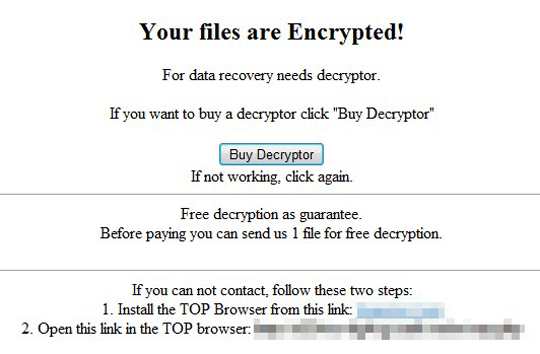RANSOM_CRYPMOD.R002C0RLT17
Trojan-Ransom.Win32.Crypmod.ytx (KASPERSKY), Ransom:Win32/Ergop.D (MICROSOFT), Win32/Filecoder.FV trojan(NOD32)
Windows


Threat Type: Ransomware
Destructiveness: No
Encrypted: No
In the wild: Yes
OVERVIEW
This Ransomware arrives on a system as a file dropped by other malware or as a file downloaded unknowingly by users when visiting malicious sites.
It deletes itself after execution. It is capable of encrypting files in the affected system.
It drops files as ransom note.
TECHNICAL DETAILS
Arrival Details
This Ransomware arrives on a system as a file dropped by other malware or as a file downloaded unknowingly by users when visiting malicious sites.
Installation
This Ransomware drops the following copies of itself into the affected system:
- %Application Data%\{running malware filename}
(Note: %Application Data% is the Application Data folder, where it usually is C:\Documents and Settings\{user name}\Application Data on Windows 2000, Windows Server 2003, and Windows XP (32- and 64-bit); C:\Users\{user name}\AppData\Roaming on Windows Vista (32- and 64-bit), Windows 7 (32- and 64-bit), Windows 8 (32- and 64-bit), Windows 8.1 (32- and 64-bit), Windows Server 2008, and Windows Server 2012.)
It drops the following files:
- %System Root%\Users\Public\AE09C984DF6E74640B3271EADB5DD7C65FDE806235B2CDA478E0EFA9129C09E7
(Note: %System Root% is the Windows root folder, where it usually is C:\ on all Windows operating system versions.)
Autostart Technique
This Ransomware adds the following registry entries to enable its automatic execution at every system startup:
HKEY_CURRENT_USER\Software\Microsoft\
Windows\CurrentVersion\RunOnce
BrowserUpdateCheck = %Application Data%\{running malware filename}
Process Termination
This Ransomware terminates the following processes if found running in the affected system's memory:
- sql
- outlook
- ssms
- postgre
- 1c
- excel
- word
Other Details
This Ransomware does the following:
- It deletes all shadow copies by executing the following command:
- vssadmin.exe Delete Shadows /All /Quiet
- The malware clears the remote desktop protocol connection history using the commands:
- reg delete "HKEY_CURRENT_USER\Software\Microsoft\Terminal Server Client\Default" /va /f
- reg delete "HKEY_CURRENT_USER\Software\Microsoft\Terminal Server Client\Servers" /f
- reg add "HKEY_CURRENT_USER\Software\Microsoft\Terminal Server Client\Servers"
- cd %userprofile%\documents\
- attrib Default.rdp -s -h
- del Default.rdp
- The malware deletes all Event Viewer log files using the commands:
- for /F "tokens=*" %1 in ('wevtutil.exe el') DO wevtutil.exe cl "%1"
It deletes itself after execution.
It is capable of encrypting files in the affected system.
Ransomware Routine
This Ransomware avoids encrypting files with the following strings in their file name:
- ..doc
- Read___ME.html
- AE09C984DF6E74640B3271EADB5DD7C65FDE806235B2CDA478E0EFA9129C09E7
- {Running malware file name}
It avoids encrypting files found in the following folders:
- Windows
- Microsoft
- Microsoft Help
- Windows App Certification Kit
- Windows Defender
- ESET
- COMODO
- Windows NT
- Windows Kits
- Windows Mail
- Windows Media Player
- Windows Multimedia Platform
- Windows Phone Kits
- Windows Phone Silverlight Kits
- Windows Photo Viewer
- Windows Portable Devices
- Windows Sidebar
- WindowsPowerShell
- NVIDIA Corporation
- Microsoft.NET
- Internet Explorer
- Kaspersky Lab
- McAfee
- Avira
- spytech software
- sysconfig
- Avast
- Dr.Web
- Symantec
- Symantec_Client_Security
- system volume information
- AVG
- Microsoft Shared
- Common Files
- Outlook Express
- Movie Maker
- Chrome
- Mozilla Firefox
- Opera
- YandexBrowser
- ntldr
- Wsus
- ProgramData
It appends the following extension to the file name of the encrypted files:
- ..doc
It drops the following file(s) as ransom note:
SOLUTION
Step 1
Before doing any scans, Windows XP, Windows Vista, and Windows 7 users must disable System Restore to allow full scanning of their computers.
Step 2
Note that not all files, folders, and registry keys and entries are installed on your computer during this malware's/spyware's/grayware's execution. This may be due to incomplete installation or other operating system conditions. If you do not find the same files/folders/registry information, please proceed to the next step.
Step 3
Delete this registry value
Important: Editing the Windows Registry incorrectly can lead to irreversible system malfunction. Please do this step only if you know how or you can ask assistance from your system administrator. Else, check this Microsoft article first before modifying your computer's registry.
- In HKEY_CURRENT_USER\Software\Microsoft\Windows\CurrentVersion\RunOnce
- BrowserUpdateCheck = %Application Data%\{running malware filename}
- BrowserUpdateCheck = %Application Data%\{running malware filename}
Step 4
Search and delete this file
- %Application Data%\{running malware filename}
- %System Root%\Users\Public\AE09C984DF6E74640B3271EADB5DD7C65FDE806235B2CDA478E0EFA9129C09E7
- {path of encrypted files}\Read___ME.html
Step 5
Scan your computer with your Trend Micro product to delete files detected as RANSOM_CRYPMOD.R002C0RLT17. If the detected files have already been cleaned, deleted, or quarantined by your Trend Micro product, no further step is required. You may opt to simply delete the quarantined files. Please check the following Trend Micro Support pages for more information:
Step 6
Restore encrypted files from backup.
Did this description help? Tell us how we did.


